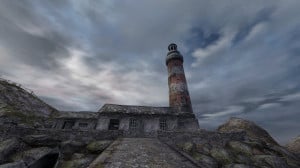
Dear Esther is all about the poetry, the visuals and the gloomy nature of this island of the Hebrides, Scotland.
Do you remember what happened to Esther, Donnelly, Paul and Jakobson on the road to Damascus? Because I sure don’t, and I’ve finished the game. The real question is, have I failed a puzzle or have I simply “played” a digital poem? Dear Esther poses these questions and more while, in a smooth English accent, sweetly declining to answer any of them.
You begin at the shore of what you later learn to be an island of the Hebrides, Scotland, and a narrator introduces you to an abandoned lighthouse with the above quotation. Your perspective is first-person and presumably you are either the narrator or following in his footsteps as you wander the dreary, desolate, serene world while he reads letters written to someone named Esther.
With no apparent objective, you chart your way around the island listlessly, hearing only the spacious, ambient piano score and the occasional foreboding words of the narrator who seems to recount the story of a tragic car accident featuring Esther and the other three characters mentioned earlier.
Mind you, the narrator does this through abstract, poetic fragments weaving in more metaphors and Biblical allegory than anyone could possibly make sense of. However, considering some of these story fragments generate randomly and there are a few slightly different paths you can take to the ending, the game is clearly intended for multiple playthroughs — especially as it clocks in at a mere two hours.
And just how do you play it exactly? It sounds like an inane question, but so far the description seems like something much closer to a film than a game. Is it even a game?
Much like your journey in the game, the production of Dear Esther had simple, skeletal beginnings. It was originally created as a free PC mod of Half-Life 2 by developer thechineseroom in 2008, which was just a research project at the University of Portsmouth then.
The mod reached cult status and after winning Best World/Story at the IndieCade Independent Game awards in 2009, thechineseroom began re-developing Dear Esther as its own full-fledged PC game, with an extended story and a complete overhaul of the visuals and level design, making it less confusing for players to find their way around. And here I was about to complain about getting lost too many times.
With enough community support, the remake was released on Feb. 14 and since then has been gaining immense critical acclaim in addition to winning the Excellence in Visual Arts Award at the Independent Games Festival. Now it certainly sounds like a game doesn’t it?
What makes it feel less like a game is when you actually play it. Yes, you can move and look in all directions as in any first-person shooter, however you cannot jump, crouch or interact with any object at any time in the game. On a functional level, this can be tiresome as I often found myself stuck on rocks and forced to spend much of my time re-tracing my steps.
Even when you venture into a dark cabin, your flashlight turns on by itself. The only tool at your disposal is a slight zoom via mouse click — as if your character is squinting at some minute detail in your surroundings. As you explore the island, you stumble upon all sorts of clues to the story: broken car parts, photos, Bible verses in luminescent paint on the walls and underwater hallucination scenes. And a few ghosts. Did I mention this game was surrealist?
It often feels less like playing a game and more like reliving a memory. True, it is still an interactive environment insofar as your movement through the space cues music and narration, and your capacity for observation determines how well you can unravel the cryptic story, but despite its lack of clear direction, the game is still very linear.
And much like a memory, the environment will occasionally give you slightly different information than the last time you played it, but the story is largely the same and you end up in the same place. The world, like the tragic event you are trying to unfold, is static and unchangeable but full of enticing secrets. All you can do hike through the desolate past and observe.
You may even find yourself taking screenshots of clues to piece together later while you attempt to reminisce with the narrator who pulls you through his experience, his identity oscillating between every character as he reads the letters, becoming increasingly distraught and ambiguous, the music becoming heavier, more orchestral and emotive. This is no puzzle game. This is literature; the narrator is the author, you are the reader and both of you are the protagonist.
And if games can be called digital literature, this title would be literary fiction. How on Earth then does it keep you entertained? I will admit the game requires patience, but I was surprised to find how engaged I was simply walking around with no pressure from external goals or judgements of my performance — I likely have the natural beauty and enigmatic artifacts of the island itself to thank for that.
As you can tell, you need to be in the right mood for this. Though it’s only two hours for a single playthrough, this game is not for someone looking for a flashy physics puzzle or bubble-gum shooter, but if you’re having trouble deciding between your English homework and playing a video game, try curling up with Dear Esther. There are no points, no winning or losing, and no rush; just eerie beauty and mystery. And when you’re finished, just be sure to ask yourself: What do you remember?
—
Image: Supplied